The Twenty Minute Omelette
October 4, 2007
15:51 PM
A friend of mine went to stay in a B&B in an Irish city lately where, before they went to bed they were asked to order what they wanted for breakfast because if they wanted an omlette for breakfast “It took twenty minutes to prepare”
A good way of ensuring that no-one would order it I’d say.
Would you want to eat an omelette that took 20 minutes to prepare?
The most renowned omelettes of all time were those made by Mme. Poulard in her eponymous Hotel on Le Mont St. Michel.
Elizabeth David tells us that she gave her recipe to M. Robert Viel, a celebrated collector of French recipes in a letter in 1922:
Monsieur Viel,
Voici la recette de l’omelette: je casse de bons oeufs dans une terrine, je les bats bien,je mets un bons morceau de beurre dans la poele,j’y jette les les oeufs et je remue constamment.
Je suis heureuse, monsieur, si cette recette vous fait plaisir.
“Annette Poulard”
This is such a gloriously simple recipe and in such simple French that I think it needs no translation.
If obeyed to the letter a perfect omelette would be produced by this method in (at most) five minutes, I have produced one in two.
I rest my case.
2 comments
Fisherman’s Souffle Pie
October 2, 2007
10:51 AM
It is funny how, like fashions in clothes, food fashions come around again.
Both Fisherman’s Pie and Shepherd’s Pie, staples of my youth about 50 years ago, seem to be having another burst of popularity, or maybe it is just that they never went away.
They have a lot to recommend them, there is no last minute fiddling and they are the ultimate comfort food, warm, soothing, easy to eat and with just the right touch of nostalgia.
Last Saturday I was faced with a dinner party dilemma.
We were going to be five for dinner and the entire party (including the host and hostess) were going off on a trip to Lismore in the afternoon.
Ideally I should be able to pop in the door at 6.30 with the guests and then have the dinner on the table in about 45 minutes.
This called for planning of a high order.
First course, soup, no bother just re-heat and serve.
Vegetables, no problem , just cook in advance and then microwave at the last moment.(I have no problems with using a microwave)
Dessert, again no problem, just something cold.
It struck me that a fishermans pie would be just perfect for the main course.
Put into the oven before the soup it would emerge golden brown and sizzling at the right moment.
It just didn’t seem festive enough to be serving nursery food at a dinner party.
Then I got a notion.
What if I substituted a cheese souffle for the mashed potato topping.
This would surely transform the mundane into something a little exotic.
I think it worked well.
Be sure and have a dish which will take all the fish pie ingredients and leave space for the souffle to rise.
Fisherman’s Souffle Pie
(feeds a generous 6)
Pie Filling;
450g (1 lb.) Salmon fillet
450g (1 lb.) Undyed Smoked Haddock
900g (2 lbs) Mussels
90g (3 oz.) Butter
90g (3 oz.) Flour
600ml (1 pt.) Milk
600ml (1 pt.) Water
Souffle topping;
90g(3 oz.) Butter
90g (3oz.) Flour.
110g (4 oz.) Mature Cheddar
4 Eggs
450ml (¾ pt.) Milk
Pie Filling:
Tip the mussels into a sink and rinse off any sand.
Put them into a pan with a cup of water and put them on the heat, covered with a lid.
Keep these on the heat until all the shells are open.
Tip them into a large bowl and discard the shells and take off the beards (any pieces of weed or fibre which the mussels attach themselves to rocks)
Put the mussels to one side and strain and keep the liquid from the pan.
In a large flat pan cover the salmon and the haddock with the milk and water and bring up to a gentle boil.
Simmer for about 5 mts then take out of the liquid and put to cool on a board.
Once the fish are cool enough to handle remove all the skin and bones and break into large flakes.
Put the fish and the mussels into a large ovenproof dish (something like a roasting tin would work well)
Melt the butter in a pan and then stir in the flour, add in the liquid from the mussels and then add sufficient of the liquid in which the fish were cooked to make a bechemal like sauce. Pour this over the fish in the dish and put somewhere cool to set.
Souffle Topping:
Melt the butter in a pan and stir in the flour and then the milk to make a thick sauce.
Grate and stir in the cheese.
Separate the eggs and whip the whites until light and thick (an electric beater makes this easier)
Beast the yolks into the cheese sauce and then fold in one tablespoon of the whipped whites to lighten the mixture.
Then fold in the remainder of the whites.
Spoon this mixture on top of the fish in the dish, smooth over the top and put into a moderately hot oven, Gas 5, 190C, 375F. for about 50 mts.
This dish is so hearty that it doesn’t really need potatoes and it goes well with a sweet vegetable like leeks which you have chopped and cooked slowly in butter or with crisp boiled broccoli.
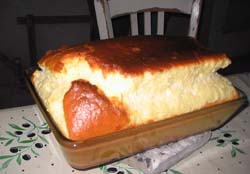
This is NOT the above but a Cheese Souffle I made
last month in France.
It did rise well though and deserved another airing.
2 comments
Last of the Summer
October 1, 2007
14:47 PM
As it is now October I should be getting to the end of
the summer shots I know so here is (hopefully) the last
of them.
These are mainly concerned with the Presbytery itself
and as we enjoyed it during the summer.
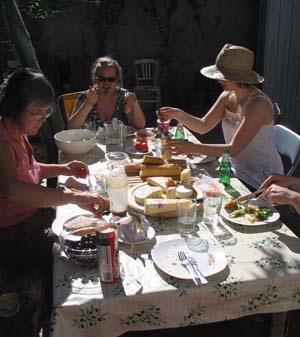
Most of our time was spent eating(as usual) and
all meals were consumed on the terrace.
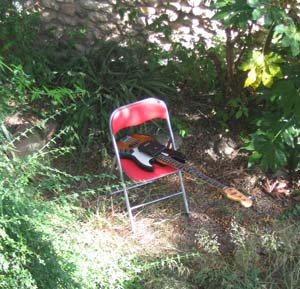
D’s boy-friend Ano came over determined to practice
his guitar but instead spent most of the time clearing
up the garden
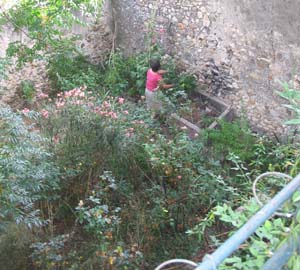
This is Sile in the garden when it was still very jungle like.
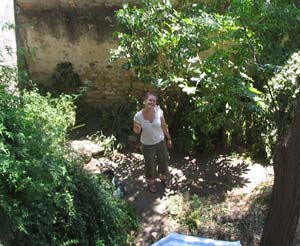
Dee in the garden as it began to reveal some of its secrets
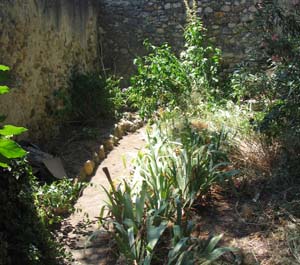
Like the paths where the Cure used to pace as he said
his daily office (as our neighbours who’s windows
overlook the garden told us)
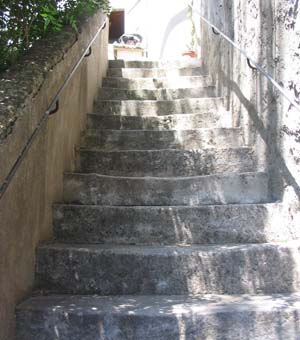
The steps down to the garden from the terrace,
when cleaned up were beautiful mellow stone.
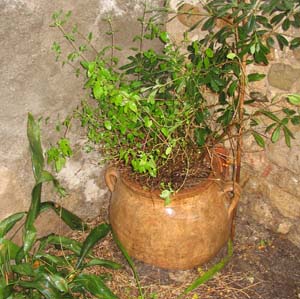
We even discovered that someone had planted
in an old oil amphora.

Up in the attic we found this wierd print of (we think)
Easter ceremonies.Not (we hope) of the Ku Klux Klan
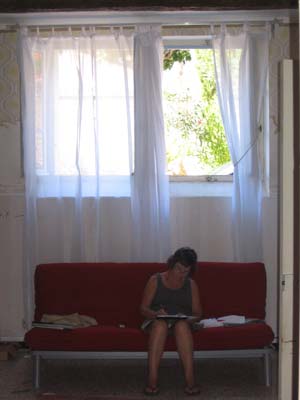
Sile on the Clic Clac, this being the French onomatopoeic
term for thier rattley but cheap bed/settees. This room
(intended to be the kitchen) was the coolest in the heat
of the day.This is due both to its cool terrazzo floor and
its northern orientation
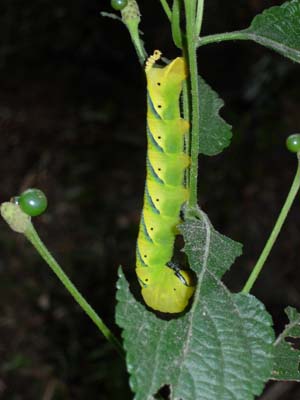
Colm found (and photographed) this, rare, caterpillar of the
Deaths Head moth in the garden
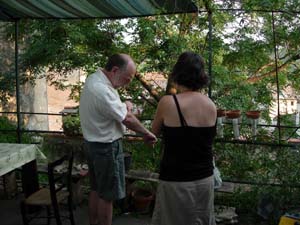
As we watered the garden the tree began to get visibly fatter
and greener. It was clearly in charge of the irrigation.
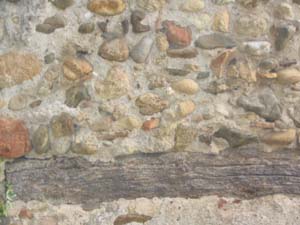
This is the wall at the end of the garden, made of stones from
the river. This wall, so we were told during the summer, also
served as the city walls but in the middle ages thus giving us
the remains of two city walls of different ages within our house
and garden.
See here for an account of the earlier wall.

Friends Michael and Paul, all dab hands with the electronics.
sorted us out with all sorts of access to radio and TV stations
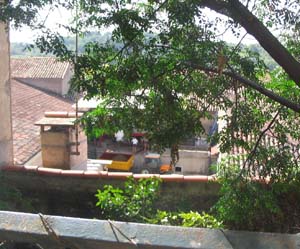
Just before we left to come home the Vendange started in the village.
These are the seeds and stems being removed from the brew.
(As seen from our terrace.)
Oom-Pah Bands
October 1, 2007
11:28 AM

Occasionally where French people are gathered together you will come across a small group of buskers playing, what I call, oom-pah music. This is usually dominated by a deep bass brass instrument, one which can fill the area with its booming notes.
On a visit to the market in Narbonne during the summer I heard this distinctive sound in the distance but by the time we found the source the band were moving on to another place to busk, so I had to photograph them from the back as they moved on.
The tuba must be the most unlikely busking instrument.
In 1988 we were in Dournanez at a festival of boats and eating Andouillettes in a huge fish warehouse which had been converted into a thousand seater restaurant for the festival.
In came an oom-pah band, complete with tuba and, to my great satisfaction they began to play one of the few French pop songs which I knew the chorus of.
And so, with the thousand other diners, I sang along with the Francoise Hardy sixties classic, Tous les garçons et les filles de mon âge……
More Lismore
September 30, 2007
12:11 PM
I went back to Lismore yesterday, mainly to show Sile and some friends the exhibition which I had seen there a couple of weeks ago.
We also had a wander around the grounds so I took some pictures of the gardens, including some of their modern art pieces, and we afterwards strolled in the village and into the catherdal with its Burn Jones window.
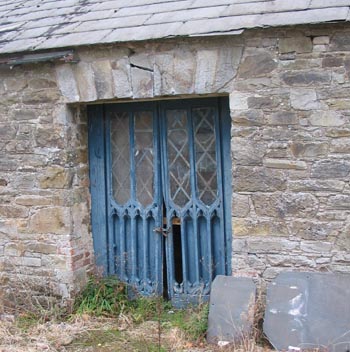


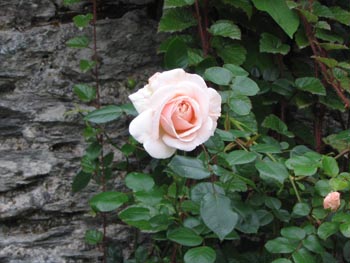

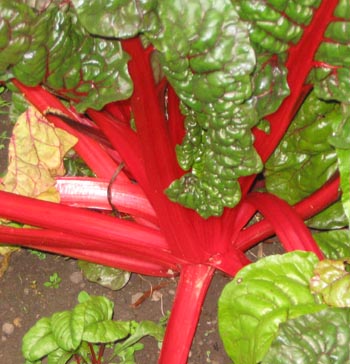



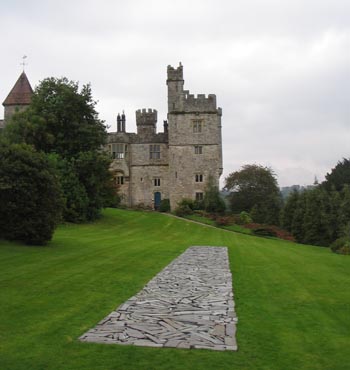
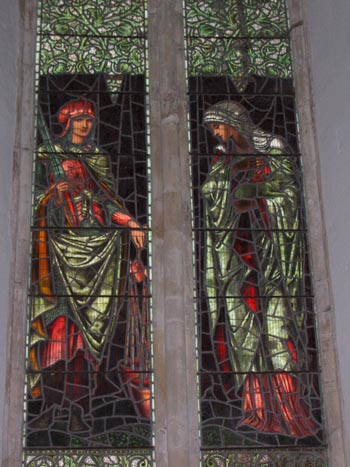
Tomato and White Peach Salad
September 27, 2007
11:55 AM
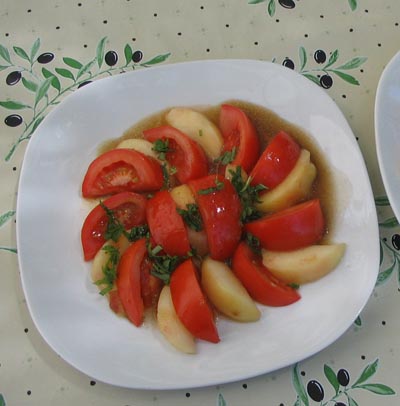
This is I know a recipe totally inappropiate to this time of year but as the cold hits in I just want to give myself a breath of the warm south.
One of the first things I do as soon as I get to a French market, or supermarket, in the summer is to buy some white peaches.
As soon as I have them I will try to, surreptitiously, smell them.
I am always brought back to the greenhouse in Tree Tops the house where I was born and raised.
We were lucky enough to have been brought up in a house in suburban Cork which had a very large fruit and vegetable garden and these fruits and vegetables were my mother’s pride and joy.
Every summer the greenhouse produced a crop of white peaches.These, unlike the yellow peach, do not grow outdoors in Ireland so weren’t common.
They have a wonderful evocative smell in the way a lychee or a melon has but it isn’t really like either.
Next time you see a ripe one for sale buy it, they are I promise quite different to the yellow variety.
The other crop which my mother grew in the green house, and these she sold, were tomatoes. Now everyone knows the wonderful sweet musky smell you get from tomatoes on the vine.This combination of perfumes made the green house a wonderful bath of peach and tomato scents, bottled it would certainly have outsold anything Chanel could have blended.
A couple of years ago I came across a Salad Composee of Nectarines and Tomatoes.
These surprising ingredients worked so well together I put it on the menu as a starter in the restaurant and that it sold well would be obvious from the fact that it became a summer standard.
It took me until this summer though before the penny dropped and I decided to put together the tastes and smells of my mother’s greenhouse.
Freshly made with fruits made sweet in southern sunshine it is very close to perfection.
Tomato and White Peach Salad
(for 4 Salads)
6 Ripe White Peaches
6 Large Ripe Vine Tomatoes
1 Tablespoon Balsamic Vinegar
4 Tablespoons Olive Oil
Good Pinch Sugar
Salt and grinding of Pepper.
12 fresh Basil leaves roughly chopped
Peel the peaches (if necessary loosen the skins by briefly plunging into first boiling then immediately into cold water) and slice in wedges against the stone then slice the tomatoes in similar shaped wedges.
Alternating the two fruits, arrange in overlapping circles on 4 plates.
Dress each one on its plate by sprinkling over the oil, vinegar sugar and pepper and lastly the Basil.
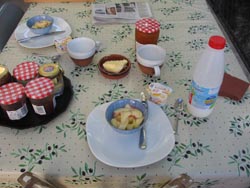
White Peaches and Vanilla Fromage Blanc for breakfast.
Another marriage made in heaven.
Lost in Translation Seventeen
September 26, 2007
08:53 AM
A friend who lives in that part of suburban London known as the Costa del Sol tells me that the English man abroad likes to display his proficiency in Spanglish by chucking babies under the chin and saying “Lovely Bambino” to the bewilderment of the Spanish parent. The Spanish word for a child is niño (or niña,) the word bambino is of course Italian.
Mind you the Spanish should be getting used to foriegners inventing their language for them.
When Bizet was writing his Spanish opera, Carmen he found it difficult to fit the word Matador into the march he had written which was central to the opera.
You all know it; Tum tumty tum, tum tumty tumty tum.
The trouble was that Matador was one syllable short. Nothing daunted Bizet invented the portmanteau word Toreador which fits the tune beautifully.
The trouble was that the word stuck and Matadors, to their anger, are still called Toreadors to this day.

A Spanish baby reacts in confusion to being addressed as bambino.

A Matador reacts to being called a Toreador.
Lady Mondagreen
September 25, 2007
20:19 PM
My daughter Caitriona wrote to me lately about the term “shoo in” or as it is more often, and incorrectly, written “shoe in”. This is an example of an “eggcorn” or a word incorrectly written which appears to make more sense than the original.
Those of you who, like me, like that sort of thing can now have hours of harmless fun googling in eggcorn to find other examples.
I did, and this in turn led me to a wonderful and newly coined word ; “mondagreen”
This is what I found when looked it up:
“The American writer Sylvia Wright coined it in an essay “The Death of Lady Mondegreen”, which was published in Harper’s Magazine in November 1954.
She wrote:“When I was a child, my mother used to read aloud to me from Percy’s Reliques. One of my favorite poems began, as I remember:
Ye Highlands and ye Lowlands,Oh, where hae ye been?
They hae slain the Earl of Murray, and Lady Mondegreen.
The actual last line should be “And laid him on the green”,
This is absolutely perfect for a person, like me, obsessed with words, a beautiful coinage indeed.
I distinctly remember from the prayers during the Rosary at home that I was always convinced that there was a part of Hail Mary which went:
“ Blessed art thou, a monk swimming” this was way, way more interesting a picture to while away the Rosary hours than “Blessed art thou amongst women”.
One Mondagreen I particularly remember being shocked with was when a great friend of mine came back from her first term of studying to be a nurse to the intellectually disabled.
I heard the song she was singing and assumed that it was the result of a new confrontational approach to nursing the mentally challenged.
She was singing “Remember you’re a Womble”
Unfortunately I misheard it as “Remember you’re a Mongol”
Pop songs are a particularly rich source of mondegreens, I remember with fondness in the the eighties as Huey Lewis sang “Go and get stuffed!” a much better line than “Goin gets tough”
One could even invent deliberate mondagreens.
I always wanted Glen Cambell to be “Singing in Dwyers” rather than “Singing in the wires” and always wanted to support the Wolf Tones when they said;
“Every man must stand behind the men behind Dwyer”
Now just last weekend one of my daughters said that they found my blog easier to read when there was a picture.
So here is, to coin a phrase, a Mondagreen Picture of the dead Lady Mondagreen.(With profound apologies to Millais-and Shakespeare)
(We must assume that the Earl of Murray has already been buried)

2 comments
Back to School
September 24, 2007
12:25 PM
I am reading with much interest Caroline from Bibliocook’s adventure as she does the Darina Allen course in Ballymaloe Cookery School.
I have the utmost respect for Darina and her teaching methods, I have taken on several chefs over the years who have been trained by her and found the training to be very sound.
At the Slow Food , Terre Madre last year in Turin there was a symposium for the 1,500 odd chefs present. One of the first to speak was Darina who gave a simple account of the way she trained her students, by picking their own vegetables, plucking the eggs from the hens and collecting the fish directly from the boats in Ballycotton.
One of the later speakers was Alice Waters from Chez Pannisse in California, a lady who has had as much of an effect on American cooking as Myrtle Allen has here.
Ms Waters prefaced her speech by saying that she wanted to announce that, having listened to Darina, any student from Ballymaloe could be able find work in Chez Panisse.
Praise indeed.
There is every evdence from Caroline’s description of the course that the students are worked extremely hard with a fair amount of the time spent looking at where the food actually comes from.
This is such a good basis for the study of any sort of cuisine.
When we in Euro-Toque gave a symposium about children’s dietary habits a few years ago Giacomo Moioli of Slow Food International, said that they had only managed to effect children’s diet by starting a school vegetable garden.
There is no doubt that watching something grow gives you an great appetite to eat it.
1 comment.
Weathering
September 20, 2007
14:16 PM
 
It’s two years now since we laid the sandstone at the back to pave a bit of the garden.
It is interesting to see how it has changed colour as it has weathered into being a part of the landscape,or then again maybe it is just dirty.
1 comment.
|
